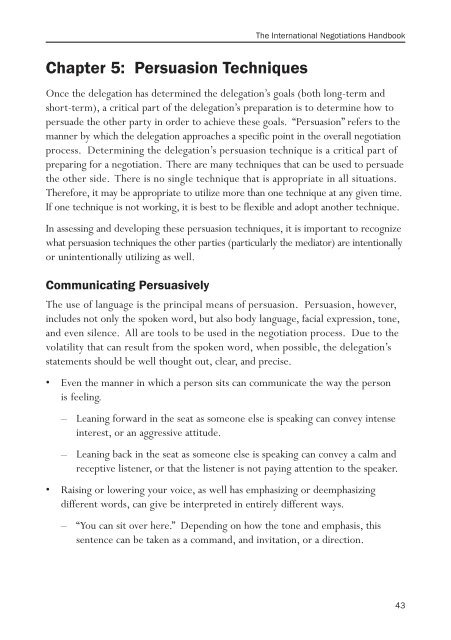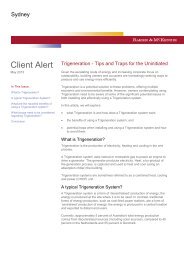The International Negotiations Handbook - Baker & McKenzie
The International Negotiations Handbook - Baker & McKenzie
The International Negotiations Handbook - Baker & McKenzie
Create successful ePaper yourself
Turn your PDF publications into a flip-book with our unique Google optimized e-Paper software.
Chapter 5: Persuasion Techniques<br />
<strong>The</strong> <strong>International</strong> <strong>Negotiations</strong> <strong>Handbook</strong><br />
Once the delegation has determined the delegation’s goals (both long-term and<br />
short-term), a critical part of the delegation’s preparation is to determine how to<br />
persuade the other party in order to achieve these goals. “Persuasion” refers to the<br />
manner by which the delegation approaches a specific point in the overall negotiation<br />
process. Determining the delegation’s persuasion technique is a critical part of<br />
preparing for a negotiation. <strong>The</strong>re are many techniques that can be used to persuade<br />
the other side. <strong>The</strong>re is no single technique that is appropriate in all situations.<br />
<strong>The</strong>refore, it may be appropriate to utilize more than one technique at any given time.<br />
If one technique is not working, it is best to be flexible and adopt another technique.<br />
In assessing and developing these persuasion techniques, it is important to recognize<br />
what persuasion techniques the other parties (particularly the mediator) are intentionally<br />
or unintentionally utilizing as well.<br />
Communicating Persuasively<br />
<strong>The</strong> use of language is the principal means of persuasion. Persuasion, however,<br />
includes not only the spoken word, but also body language, facial expression, tone,<br />
and even silence. All are tools to be used in the negotiation process. Due to the<br />
volatility that can result from the spoken word, when possible, the delegation’s<br />
statements should be well thought out, clear, and precise.<br />
• Even the manner in which a person sits can communicate the way the person<br />
is feeling.<br />
– Leaning forward in the seat as someone else is speaking can convey intense<br />
interest, or an aggressive attitude.<br />
– Leaning back in the seat as someone else is speaking can convey a calm and<br />
receptive listener, or that the listener is not paying attention to the speaker.<br />
• Raising or lowering your voice, as well has emphasizing or deemphasizing<br />
different words, can give be interpreted in entirely different ways.<br />
– “You can sit over here.” Depending on how the tone and emphasis, this<br />
sentence can be taken as a command, and invitation, or a direction.<br />
43

















